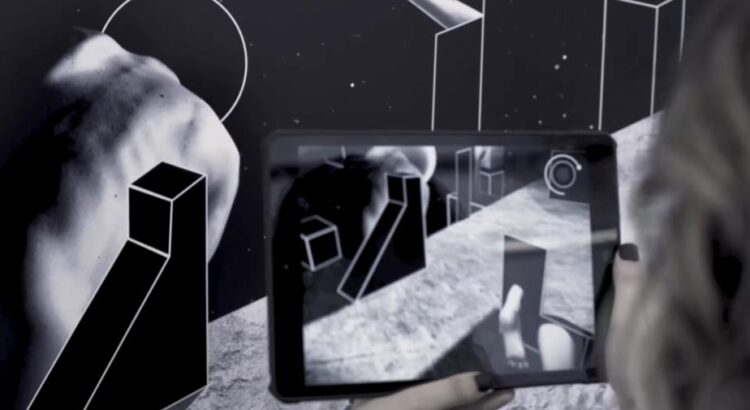**featured image a screenshot from the final frame of “Gone” on Virtual Mutations, Camila Magrane
9:00am • Monday, January 30, 2023 • Institute for the Humanities Gallery
Traces captured many emotions and impressions in the small space of the Institute for the Humanities Gallery, and in the even smaller spaces of single Polaroid photos. The exhibition, created by Camila Magrane, involves a series of Polaroids and larger collages which visitors view through the lens of an augmented reality application called Virtual Mutations. It took a little while for the app to download, but the effect was impressive once I held my phone up to Magrane’s works. In some, platforms telescoped out of the scenes while footprints wove their way in and out of the frame; in another, crows appeared to flock out of the frame and surround the viewer. Overall, I was able to use the technology fairly seamlessly to access the whole experience–in some cases the image on my phone fell out of line with the actual frame, or I needed to move around in order to get the animations to begin, but once I began it was easy to navigate the exhibit.

One of the themes Magrane promised to explore in the works featured in Traces was the connection between the past and present, and my favorite example of this theme was in “Gone,” one of her larger collage pieces. Once accessed through Virtual Mutations, the viewer moves slowly through the window in the center, through which appears another window in another wall, creating an Escher-esque illusion. Literally tying together the different versions of the scene is a white rope, appearing in different arrangements with the other furniture and the fish that make up the scene. Eventually the window gives way to a shore, with the white rope leading out unendingly into the ocean. I felt that I was tracing the path of whoever had disappeared into the waves, watching the remnants of their life subsumed by successive tides.

The Polaroids in the exhibit added a different facet to the overall mood of the gallery. Each Polaroid, or small arrangement of Polaroids, was titled with an emotional or psychic state, like “Angst,” “Rapture,” “Tension,” or “Anticipation.” To me, these titles also served the theme of Magrane’s work by alluding to a Before and After, or the tension of the in-between. Viewed through Virtual Mutations, the animated Polaroids featured the repetitive movement of human forms–I felt like they activated my mirror neurons, nudging me towards a phantom experience of the emotions they portrayed.
Overall, Traces created a powerful and surreal space that nudged me to think more deeply about the relationship of technology with art. The convergence of antique technologies like Polaroid film and cutting-edge ones like virtual reality lent a sense of timelessness to Magrane’s work. I highly recommend the exhibit to anyone passing by the Institute for the Humanities Gallery as a bite-sized look into the future of interactive art.



